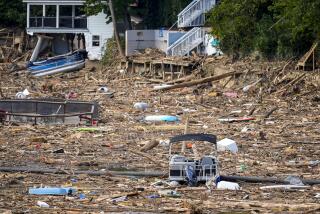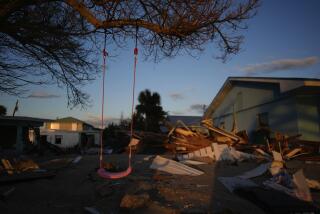Hurricane Relief Blows in Winds of Change for Military : Disaster: With the Cold War ended, some welcome emergency aid role for troops. But others see risks of armed forces usurping civilian commands.
- Share via
HOMESTEAD, Fla. — South Florida’s dominant color is now drab olive green. Every neighborhood crawls with soldiers dressed in camouflage. Almost every intersection is staffed by a military police officer directing traffic. The rumble of military trucks goes on around the clock.
There was no thunder of advancing armament, no heroic charge. But the American military has advanced with martial precision on hurricane-ravaged Dade County, leaving a trail of tent cities, mobile kitchens, portable toilets and emergency supplies in its wake.
Coming on the heels of a deployment of 4,000 active-duty troops to riot-torn Los Angeles, the Bush Administration’s decision to send up to 35,000 troops into South Florida underscores the shifting demands being placed on America’s armed forces in a post-Cold War world. Yet despite the comparatively low risk to life entailed in noncombat missions, the Pentagon is learning that such non-traditional operations are neither simple nor free of political entanglements.
Military commanders in Florida are learning lessons about civil disasters that civilian emergency service experts learned long ago. The military involvement also has rekindled fears about the scope of military control over civilians and raised new concerns by elected officials who suggest the Pentagon will try to overemphasize such relief efforts to stave off legitimate budget cuts.
“There’s a tension built into this kind of problem: The military’s primary role--indeed, its reason for being--is national defense, which is basically different in that it involves the use or threat of force against real or potential human adversaries,” says Eugene Fidell, a Washington attorney who specializes in civil-military relations.
Defense Secretary Dick Cheney, who is struggling to maintain a force of 1.6 million active-duty troops in the face of big budget cuts, was quick to defend the deployment: “We are a disaster relief agency. In reality, we get heavily involved in that. We have all over the world.”
Last week, Air Force planes were flying 700 missions a day, supporting firefighting operations in California and Idaho, humanitarian relief efforts in Somalia, Russia and Yugoslavia, and peacekeeping forces in Angola.
Yet the skills soldiers learn to prepare for war do not always translate well into peacetime relief missions, as the Florida deployment demonstrates. Many troops here are undergoing what the military calls “cross-training”--learning a new job, on the job.
Army Pvt. George Oskew, a 21-year-old native of Columbus, Ga., is a plumber for the Army Corps of Engineers. But the corps has no need for plumbers in South Florida, and so Oskew this week is learning a new task--how to operate dump trucks and bucket loaders--so he can assist in clearing debris.
In a Miami Herald opinion piece, Sen. Bob Graham (D-Fla.) called for soldiers to receive better training in disaster relief. Describing a visit to a relief center that served only Spanish-speaking victims, Graham noted that none of the officers spoke Spanish.
“With the Cold War all but gone, our military is shrinking and refocusing its mission. Part of this transformation should include a re-orientation to train military personnel for disaster response,” Graham wrote.
The troops arriving in Florida were generally received like an army of liberation by demoralized residents and by discouraged disaster relief specialists whose pleas for help drew little response for days.
Three days after the hurricane hit, Kate Hale, Dade County’s director of emergency operations, drew national attention when she said: “Where the hell was the cavalry?” Less than a week later, she was able to remark that “today, there is no doubt that they’re here.”
To build relationships in the community, the military assigned commanding officers specific areas to monitor, down to individual city blocks. The idea is to keep the same soldiers assigned to the same blocks for the duration.
“These people are going to see basically the same soldiers,” said Lt. Col. Steve Ritter, public information officer for the operation. “There’ll be some bonding.”
Residents, for the most part, have welcomed the arrangement. “They are God-sent,” exclaimed 70-year-old Catherine Deleveaux of Florida City, listening to the radio in the dark living room of her devastated home as soldiers cleared her yard of fallen avocado and mango trees. “I am handicapped and my husband is too, and they just come in like champs, and I’m so happy for them.”
The military has also succeeded in getting supplies to the area. Soldiers are passing out food, water, sanitary items and other necessities to long lines of residents. Yet those long lines also indicate problems with one of the central elements of the military response: Most residents did not initially move to the tent cities that were erected to provide basic needs of food and shelter. They preferred instead to stay in their homes, coping with makeshift roofs of plywood and plastic, collapsing walls and soaked rugs.
After some initial hesitation, however, the tents began filling up this week.
Civilian emergency services experts were not surprised by the Floridians’ hesitation.
Eileen Baumgardner, assistant director for planning and preparedness for the California Office of Emergency Services in Sacramento, said recent research, and common sense, has shown that disaster victims “want to stay with their homes” rather than be uprooted to large, centralized shelters.
Disaster victims also have psychological needs that are met by remaining near their property, even though it is badly damaged, Baumgardner said. “It’s important to let people stay near their homes so they can start restoring their lives and repairing family relationships.”
While the military involvement grows in South Florida, so does a re-emerging concern that reaches back to the Civil War: How much control should the military have over any aspect of civilian life?
“There’s always been a reluctance on the part of the military to be drawn too closely into non-national-defense functions,” said Fidell. “And, correspondingly, there is a vein of hostility in American political culture to too deep an involvement on the part of military personnel in non-national-defense activities.”
After the Civil War, lawmakers reflected this longstanding suspicion of granting the military a role in civil affairs, dictating in 1878 that no U.S. troops are to be directly involved in the search, seizure or arrest of American citizens.
For many disaster relief experts, including those from the civilian Federal Emergency Management Agency, involvement by the armed services today raises concerns that the military is inclined to usurp authority.
“I have a hunch the military would like to have FEMA get out of the way and let them do these missions themselves,” said Rep. Curt Weldon (R-Pa.), a member of the House Armed Services Committee and founder of the Congressional Fire Services Caucus. “The military doesn’t like to be directed by FEMA for these missions.”
Military officials in Florida say they are sensitive to those issues. “We’re not here to take over and run things,” said Maj. Gen. Steven Arnold, who is commanding the relief effort in Dade County’s hardest-hit areas. “We’re here to assist city governments and county governments to get back on their feet.”
In Florida, the relief effort is being run by a joint task force composed of the military, FEMA and state and local authorities.
Like many experts, Weldon also said he fears that in a contest over the budgets and prerogatives that go with these relief missions, beleaguered civilian agencies would lose to the Pentagon. As the Defense Department, currently reeling from budget cuts, struggles to fend off deeper reductions, Weldon said he expects the Pentagon to try to muscle in on the civilian humanitarian missions.
“Obviously, if you don’t have an external threat, real or perceived, to help drive your budgets, you’ve got to look for other tasks” to justify your budgets and programs, he said.
Healy reported from Washington and Stolberg from Homestead. Times staff writer James Bornemeier contributed to this story from Washington.
More to Read
Sign up for Essential California
The most important California stories and recommendations in your inbox every morning.
You may occasionally receive promotional content from the Los Angeles Times.











